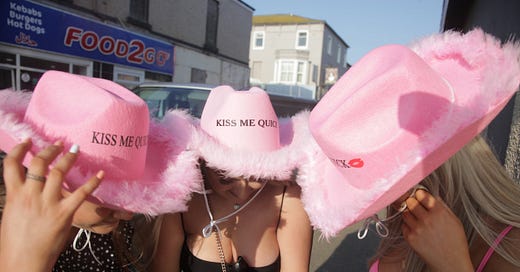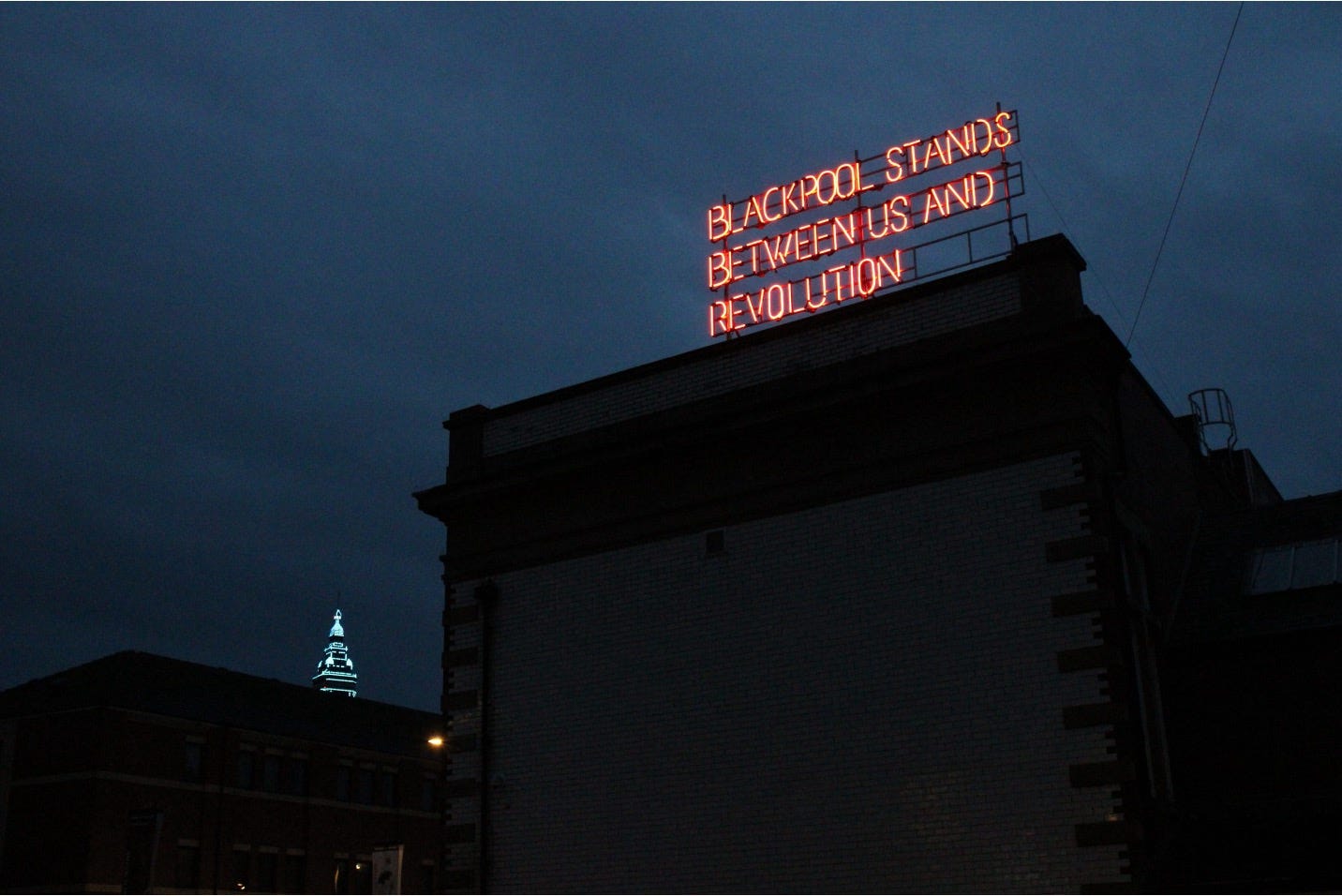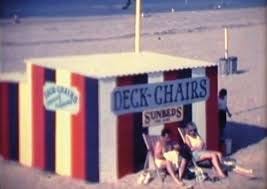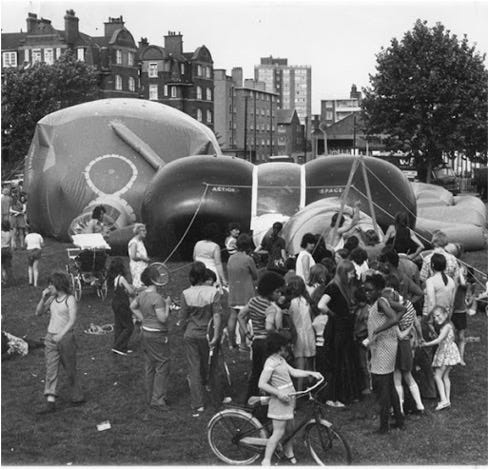On Friday I was lucky enough to be invited to speak as part of the events series for the exhibition Lives Less Ordinary, curated by Samantha Manton at Two Temple Place. Below is an edited version of the lecture I gave. It’s an attempt to use the cultural history of the seaside and the fairground as ways to think briefly about the history of class and pleasure in Britain. I was trying to bring together material that I think plays with or evokes particular classed feelings: pangs of nostalgia / rushes of injustice / waves of fear / tiny little spikes of recognition / perhaps, even, moments of pleasure itself. If you haven’t seen Lives Less Ordinary yet, it’s on until the 20th of April - I can’t recommend it enough.
***
In 2022, an illuminated text-based work, designed by artist Tom Ireland, was placed temporarily on the roof of the Grundy Gallery, in Blackpool. The work was a response to an open call commissioning opportunity by Blackpool Council, and afterwards, was added to Grundy Art Gallery’s permanent collection, which possess light based artworks by artists such as Tracey Emin, Chila Kumari Burman, and Tony Heaton. I wonder if it isn’t a coincidence that each of those artists, playing consciously with neon’s crass connotations, come themselves from working-class backgrounds. I wonder how many of them might have driven through Blackpool’s own illuminations as children - a whole night out contained in and refracted by, a foggy backseat window.
I wonder if it matters if they did, and if that question comes from a sense that the bright lights of the fairground have something childlike about them - something simple seeming, something wonderous. Or, perhaps, if it comes just from an instinctive sense that these aesthetics could only be meaningful to those that have personal connections to them. Much as the industry of such places is now pointedly designed around nostalgia, I don’t think that is true.
I’m asking this question partly because after I spoke on Friday, a well-intended listener and artist suggested that she had struggled with my presenting my ideas in such a “middle-class way” a comment that was infuriating, upsetting, and helpfully provoking in equal measure. Though I didn’t act on it, my instinctive response was to try to prove my credentials for speaking about class (always a doomed endeavour). I wanted to send her a postcard from my own, younger self, a piece of frayed-edge evidence to say: look! here I was! (and look! part of me is still there!) A strange bent on Wish You Were Here.
Of all the writing on Blackpool, Paul Theroux’s always sticks in my mind. There was no relief! he writes, pleasingly afraid. Theroux wrote about Blackpool as pure idea, so rich with cultural signification as to mean nothing other than to those with their own personally mythologised experiences of it. Another way of putting it, maybe, is that to talk about Blackpool is almost always to talk about class. It too is almost always mythologised; fraught, intense, defensive. All things I felt on Friday.
As I write this, I realise that another, different piece is hammering on the door to be let out, a piece about social mobility and elitism and inverse snobbery and fear and what accessibility means and how utterly bizarre it is to come through a system in which particular forms of writing and speaking and holding yourself are made to seem like the only way you can do well, only to be told, having done so, that you should really be better at being your authentic self. (Much to the disappointment of such people, my meaningfully authentic self really does have such a grandiose and academic way of speaking, but “authentic” in the context it was put to me seemed, as often, to simply be a byword for simplistic and caricatured.) Many have articulated that experience better than I yet can, and that isn’t the piece I’m writing now, anyway. But I still wanted to mention that moment, of horror and recognition and petty annoyance, partly because it’s coloured the way I think about the writing below. Partly too because I wonder if there was something about all this talk of the seaside that brought out a particular intensity of feelings. Of youth, and vulnerability, and feeling glued to where you came from, of wanting to get into the car and drive back home, to a place where you understand things entirely.
Back, though, to the lights. When Blackpool illuminations were first displayed in 1879, they were described as an “artificial sunshine.” Incandescent, bright, glaring. Letting that phrase, artificial sunshine, linger, might be useful when it comes to some of the questions that have been playing on my mind. Artificial sunshine might be scorned as something that pretends at the real thing, but is actually a constructed, conscious, dupe: shone brightly into the eyes of the unsuspecting masses. Or, it might be something much more interesting, daring, or delightful.
For the nostalgic, the curious, or those unfortunate enough to have never ventured North of Birmingham, there are many videos available on Youtube that show Blackpool illuminations through the years. For what its worth, I think these videos are not only cultural artefacts, but an archive, a repository of the meaningfully popular, digital pieces of social history, and an insight into what might, if so inclined, be understood as an immersive cultural experience, punctuated by bursts of avant-garde absurdity.
The lights are a kind of pop art, permanently set against a usually gloomy sky. For over 140 years, they’ve acted as a creative articulation of the town’s identity, and of the identities of many working-class people in Britain. They’re also, we can’t deny, a commercial venture, more recently part sponsored by McDonalds, often reductive, and jarringly kitsch. How to hold all of these things in the air at once?
Designing, building and constructing the lights is a labour-intensive process. Over 200 miles of cable and wiring are required, and 65,000 staff hours are required each year. The lights might be thought of as a simplistic throwback to Wakes Weeks gone by, but of course, they’re the own kind of work, their own industry, too. They’re also one of few instances that I can think of, in and around the north-west of England, of a cultural experience that is entirely free.
Blackpool has long been known for its lights. The showtown museum holds an impressive collection of original designs, many of them from the 1930s, and many of which were probably never realised. These images show ordinary, perhaps even dull, civic spaces transformed into displays of awe, beacons of optimism. In one, taken from 1935, PROGRESS, then BLACKPOOL: BEST IN THE WORLD. There’s a whole national history to be written out in neon lights such as these: at once provincial and metropolitan, retro and futuristic, tacky and trendy.
This piece of writing isn’t meant to be about neon, though, but about the words the neon spells out.
BLACKPOOL STANDS BETWEEN US AND REVOLUTION.
A TLDR for all that follows. I think the kind of revolution we ought to be working towards is one that wouldn’t position Blackpool as its inconveniently distracting enemy, standing between us and revolution, but rather as a site from which to organise – the heart of the revolution itself. Which is to say that I want to be able to think about bags of sugary doughnuts, discos in opulent ballrooms, donkeys and diving boards, and artificial sunshine, not as in themselves somehow constituting a revolutionary praxis, but as cultural fragments, thick with feeling, which might reorient us in thinking about the kind of society that we want, and who gets what within it. I want to think about how we can recognise how capitalism shapes those fragments, but I also want to suggest that we can steal something back, too.
The origins of that titular quote are sketchy, and though it is often attributed to the British garden designer, landscape architect and town planner Thomas Hayton Mawson, it is more likely that it was said to Mawson, by an anonymous local businessman in 1926. In essence, it means: shiny things distract the working-classes, they disable them politically, and therefore serve the interests of those in power. Whilst the workers have their annual sedation slash sticks-of-rock, they’re easier to control. If it weren’t for those sugary sedatives, we might just have had our long-awaited revolution by now, after all.
(This is really, obviously, an argument about capitalism, about how material wants and desires distract from a “proper” class consciousness. It’s an argument often charged at women especially, for it is women that are most easily distracted, by men, handbags, reality television, depending on your age and inclination.)
But I also want to note the extent to which “our” is doing quite a lot of heavy lifting, in that complaint about “our long-awaited revolution.” We know where arguments like this so often come from, and its not often from working-class people themselves. Instead, it’s often middle-class academics or social commentators that find themselves so disappointed by a too easily distracted proletariat. This is a dynamic that has patterned the entire history of the left in Britain through the twentieth-century – we find it here, in the nineteen twenties, but we might just as well be talking about the 2020s, and the worst aspects of the contemporary labour party. Talking about the “Mass Psychology of Thatcherism” at the ICA in 1989, Valerie Walkerdine wrote that “the working-class hasn’t done its revolutionary job, bring Thatcher instead of revolution. There is huge disappointment that The Class has failed. The Left then behave like an angry child in a tantrum...”
Those that have themselves more recently spent time in working-class environments rarely fall foul to that kind of disappointment, because they’re able to appreciate that the dynamic being described, between pleasure and political consciousness, is much more complex. The title of one of the works featured in Lives Less Ordinary comes to mind: SOME OF US PREFER ILLUSION TO DESPAIR. ( Connor Coulston, via The Simpsons.)
When I hear the phrase ! Blackpool Stands Between Us And Revolution ! I think not of Thomas Mawson, but of Lindsay Anderson, who I wrote about at the start of last year. I think of his 1956 film O Dreamland, of which Gavin Lambert wrote that “everything is ugly... It is almost too much [...] Pity, sadness, even poetry is infused into this drearily tawdry, aimlessly hungry world.” Note the “even” qualifying poetry, there – that this candyfloss world might produce something poetic, something cultural, is the most unbelievable fact of them all. That phrase, “candyfloss world” is not mine, but a contemporary of Anderson’s, and a great thinker in his own right, Richard Hoggart. Many of Anderson and Hoggart’s concerns, (which came, by the way, from very different places, but were reflected by the male British left much more generally at this time) were valid, and still bear paying attention to. Namely, the influence of an increasingly ruthless form of consumer capitalism, which prioritised passive consumption, and cycles of endlessly unfulfillable desire.
I think its important to keep in mind that those forces are inseparable from the mechanisms for pleasure and leisure that we’re trying to think about, but I don’t think they’re the whole of the story. I also don’t think that everything about Anderson’s vision must be scorned, though, not least because I think he’s one of Britain’s great filmmakers, but also because O Dreamland captures a darkness to the British seaside that I think is recognisable, whether I’d like it to be or not. It’s a darkness that is the inevitable product of places built around a profit motive, built around the temporary, built around the notion of release, and then, in our own time, often left to fall into poverty and disrepair. For me, another work featured in LLO, Mark Leckey’s Dazzleddark, is interested in a similar tension, minus the condescending scorn.
Leckey has said that the film was initially going to be called “Rainbow unicorn versus the Dismal Tide” – I think it cuts at the kinds of binaries that are projected onto seaside towns, and which, inevitably, begin to become part of those towns’ own identities. I think this work is useful partly because it thinks about the seaside as a strangely kind of fetishised dreamland, a place that seems to many to lack meaningfully real inhabitants. I think that, unlike so much work on the seaside, it is also interested in the question technology, and by extension, the future. I think this is incredibly valuable, too.
Here is an image that I love.
It’s of Jennie Lee, former Arts Minister, digging the ground for the National Theatre, one product of the 1965 Policy for Arts White Paper. Lee’s vision in green lighting the National was of a cultural landscape central to everyday life, publicly supported for the benefit of all. I include this photo to flag the extent to which these issues were on the agenda in mid-century Britain, in a major way, for the first time. What does it mean to enjoy yourself? Who should get to do it? What does it mean for working-class people to enjoy themselves? Why does it matter if and how they do?
Pleasure came to be not only that which was political, but that which deserved a place at the heart of any left-wing movement. Yet what constituted that pleasure – where it might come from – what its boundaries might be, remained a contested subject. To my mind, this makes the seaside a contested space, too. Is it an irredeemable one, a project of profit and sedation, with no room for anything else? In this clip taken from 1954, Allan Prior explores Blackpool for the BBC:
In Prior’s clip, Blackpool (and its pleasures) are almost entirely, and quite unforgivingly, allied with the market driven values of post-war capitalism – individuality and competition. Blackpool is the profit motive made concrete, stock markets as big dippers, mesmerising and hypnotic.
A different perspective comes from another film made ten years later. Knees Up, Mother Brown was made in 1964 by Luciana Della Mura and Peter Smith. The film documents the daily goings on at the Darby and Joan Club, a group first established in Streatham to provide entertainment, social activities and support for Britain's elderly. The film is one of those that occupies my thoughts a lot when I’m going about my research. It offers us a vivid and at times intensely experimental portrait of an ageing working-class population, particularly its women, and the fabric of their lives. After spending the day dancing, painting, and working, at the end of the day the women travel to a fun fair -
The perspective that the women offer, and what the funfair offers them, is an oddly optimistic one, and I think a surprisingly communal one too. To enjoy that their worldview is one that predates neoliberal individualism as king isn’t neccesarily to valorise the suffering that these women experienced, nor their uncomplaining attitude towards it, but it is to point towards the possibility of pleasure – shared pleasure – as a communal experience, and one that might have to be worked at. I think it offers up a version of the fairground at odds with Allan Prior’s – not a place ruled by competition or ruthlessness, but a place in which communities can come together for release and catharsis, as an extension of their daily lives. Importantly, the film shows how they can be documented, doing so, in a way that is both tender and eclectic.
Yet still, some in mid-century Britain felt as though there was a risk that this new interest in “pleasure” was a byword for Americanised capitalism, rushed in through the back door. In 1983, Margaret Thatcher told audiences: “there are great industries in other people's pleasures!” And so, we might begin to wonder if those critics, back in the 1950s and 60s, had a point.
In one of my favourite books, Ann Quin’s 1964 Berg, the protagonist, a hair tonic salesman, finds himself sitting on a ghost train, going around and around as we leave him. Berg is a novel full of confectionary, chemicals, and wax dummies, interested in a post-war Brighton defined by artificiality and consumerism. In it, quick-hit pleasures are firmly to be feared - made surreal to such an extent that we might wonder if Ann Quin might just have been taking the piss out of all those mid-century left-wing men, who worried about all these women, with their candyfloss hair and their longings for more.
At the end of the video for Madness’ 1982 House of Fun, the band find themselves, a little like Quin’s Berg, going around and around and around on a loop-the-loop rollercoaster. The song is about coming of age, and losing your virginity, and spending a day at the fair. Asked about the meaning of the song, Chris Foreman recalled that “I think it's about coming of age [...] You could buy a packet of fags, a pint of beer and a three-piece suit for half a crown and still have enough left to go and see Rudolf Valentino at the Gaumont! I can't afford to go to the pictures these days but I hear they talk in them now.” House of Fun, then, is also a song about the place of pleasure in society, and who gets to have it.
Yet by 1982, to even be asking that question suddenly seemed again like a radical thing. Though those on the left might have disagreed about the kinds of pleasures that ought to be provided for working-class people in the 50s and 60s, it was the case nonetheless that everyday, democratised pleasure was a matter for serious, civic, and scientific, attention. A few decades later, the young boy in House of Fun is scolded: THIS IS A CHEMIST / NOT A JOKE SHOP. Over the course of a few decades, pleasure had become firmly a private matter.
In 2015, Channel 5 released Benefits by the Sea, just one of a spate of programmes by the channel that posit poverty as a form of entertainment. In the programme, the suggestion that the residents of Jaywick, one of the UK’s poorest towns, might be entitled to housing benefits, is extremely controversial. Unavoidably, it is almost always women that are vilified the most intensely. The idea that they might be entitled to not only basic economic and social support, but a life defined by fun, pleasure, and sensuality, is in twenty-first century Britain so absurd as to not even be worth mentioning.
In this classic episode of Coronation Street, taken from 1985, Bet, Rita, and Mavis pull up in Blackpool, and struggle to decide how to spend their afternoon:
I think this clip is useful to us for staging these debates, about pleasure, and leisure, what these things mean, and what they’re for, in a much more practical, familiar, context. Mavis is distressed by the pleasure beach, and would prefer instead to opt for a much more 19th century pleasure pursuit: the public park. Much less vulgar, much more natural. Bet wants candyfloss, fairground rides, and of course, sex. For Bet, the erotics of the Pleasure Beach are barely concealed.
Nor are they concealed in an episode of Arena from 1989, in which two young women set about a standard night out at the seaside, describing their pleasures and sexual pursuits via giggles and perms. Resistant glimmers might be pulled from the archive, rescued like a particularly shiny keyring in a grabber. Though some might see these women as distracted slaves to a capitalist system keeping them down – I’m not so sure that’s the whole story. There’s a resistant pleasure, I think – really evident in the fuller clip - in the way these women build a world for themselves, on the north-west coast, in the power of ritual, self-fashioning, glamour, and world building, hard fought sexual freedoms, and the unabashed commitment to having a laugh. Blackpool is theirs, regardless of what Arena’s viewers, or the men they meet, or even we, might think.
Another glimmer: in 1995, Tracey Emin made Why I Never Became a Dancer Running at just under seven minutes, the images of the seaside that Emin uses resist any one interpretation. They collude in the harm done to Emin as she narrates a history of sexual assault, but they’re also, retrospectively, the site of agency, the tools through which she can tell her own story in complex and ambiguous terms.
At the end of the film, Emin dances for the camera, and in doing so takes something of a commodified, privatised, leisure industry (that of the dance competition circuit) and claims it as a mechanism for her own exploration and play. So Why I Never Became a Dancer also plays on that connection, between the British seaside and classed, feminised, sexuality, but in a way that much more consciously reckons with the kinds of violence that equation has obscured when it comes to young working-class women themselves.
It’s important to my work, which revolves around working-class femininity in Britain, that this connection is one that has helped to aid a demonisation of working-class women in particular, from both those on the right, and those on the left. Candyfloss, and capitalism, and carnal appetites, all coalescing to delay that much longed for revolution. It seems to me that that revolution is one in which Blackpool, and its kiss-me-quick shouting women, basically has no place.
This isn’t the kind of revolution that I am dreaming of. I’m sceptical of the judgement of working-class people, finding pleasure, in whatever form it takes, where they can, but I’m even more sceptical of an argument that implies that quick-hit capitalist hedonism is the only kind of pleasure that working-class people are capable of. We know this is a story that’s been told to us, steadily, increasingly, over the twentieth century and much more intensely in the twenty-first, and I think it’s left us thinking that the seaside, and by extension, pleasure itself, can only be one thing.
And so, loving it dedicatedly as I do, I want to wonder if it is true that the seaside is defined purely by its artificiality and hollowness, that that is all that pleasure means, in contexts such as these.
Another, different kind of glimmer, one I’ve written about on this substack before. In 1961, director Joan Littlewood and architect Cedric Price began putting together the plans for a new kind of public structure, a laboratory of leisure, what they called the “Fun Palace.” As the original blueprint put it, “Dance, talk or be lifted up to where you can see how other people make things work. Sit out over space with a drink and tune in to what’s happening elsewhere in the city. Try starting a riot or beginning a painting – or just lie back and stare at the sky.” Movement, knowledge, reaching out, curiously. Paying attention, painting, playing, disrupting. The Fun Palace went through various iterations, from the Palace itself, to the idea of the Bubble City, but the most concrete of all of these was the Stratford Fair, which repurposed aspects of an older British seaside and circus culture, not in an attempt to anaesthetise or distract, but as a gateway to imagination, challenge, and play.
The Fun Palace, to me, is worth (ironically) serious thought. While it was reflective of that mid-century moment where working-class pleasure and leisure took on a newfound importance, it was also a way of doing things that positioned itself explicitly against the bureaucracy of arts council structures, and indeed against the Labour Party’s Arts White Paper. Littlewood and Price were sceptical that the changes being brought in at the time were radical or democratising enough to change the fundamental state of things in Britain, and looking back, I think they were probably right. Looking back from Madnesses privatised House of Fun to the open space of the Fun Palace, perhaps two buildings on the same street, but at different times, is an altogether depressing comparison to make.
Isn’t it possible to see the seaside as a place of complexity and innovation? And to complicate what pleasure itself means? For Littlewood, there was a difference between the passive act of leisure, and the more active, conscious, pleasure. Agree or not with her distinction, I think its undoubtedly true that the even the possibility of the kinds of pleasure she sought to encourage, with her “university of the streets” and so much more, has been systematically destroyed.
In our own time, the seaside has been depicted as a cultural monolith, and a site not of reaching out, but of borders and defence. Another work from LLO: Chila Burman’s Bengal Tiger Van, is one that defies those simplified narratives about race and culture, and also reminds us that opulence and indulgence – whilst not able to entirely escape the connotations of western capitalism, does not belong only to those things. The work is a bank note, the tiger operated as a form of advertising, and the ice-cream van is a firmly commercial enterprise – but the work also teases at the promise of making something new out of those forms, bending them to the will of the British-Asian working-class woman who wants to experiment, play, and create.
In an altogether different display – but one that I think shares an appropriation of the hallmarks of capitalism to a more resistant ends, in June 2024, Victoria Thomas Bowen, an OnlyFans model styled with the trappings of a recognisably contemporary working-class feminine glamour, throws a McDonalds Milkshake into the face of Nigel Farage, in Clacton on Sea.
The seaside has long been lazily written of as an end-of-the-line, a place for pure hedonism, or a “liminal” space in which anything is possible, but only for a long weekend. I’m increasingly trying to suggest there is something of its liberatory energies that we can steal for ourselves much more permanently, in thinking abut the kind of revolutionary politics we actually want.
For Littlewood, “lack of development of human potential is not due to inborn apathy in the individual but to lack of opportunity and incentive, to environments and educational systems which were not designed to release individual initiative but to stifle [...] If to play is to employ oneself in satisfying curiosity, vanity or pride, exercising the imagination attempting new skills and making new decisions then the Fun Palace is a playground…”
A reoccuring thought, then, going around and around //// what could be more of a playground, more of an absurd, challenging, imaginative, space, than the British seaside? ////
Another glimmer, before we come to a close. Helen Palmer, Pleasure Beach was published by Prototype Press in 2023 – it’s a retelling of Ulysses, set in Blackpool, that centres around three young, working-class women’s lives. Reading it is a reminder that the British seaside is in fact in many ways the ideal and most obvious subject for experimental cultural production. The book is an archive of fun as that which might have been commodified, but also, always exceeds, and most of all, in its form, the book is a reminder that the separation between the “high-brow” and the “low-brow” as an economic distinction, is an elitist imposition that can – and must - be resisted.
The kinds of pleasure that Littlewood championed, centring that which is emboldening, creative, imaginative, can seem a distant dream, but one of the first steps might be to reclaim those images – such as those that define the seaside – that have been so entirely defined by a particular definition of pleasure. To do so might be to play instead with the idea of the seaside as a historic locus for innovation and experiment. Returning to where we began, with the question of artificial sunshine, might be to see one small instance of this in action. Those of us lucky enough to be born in the north-west of England can testify that real-life UV rays can often be in short supply. In the context of yet another soaking day, a thing such as artificial sunshine might indeed come to seem like a wonder of necessary innovation, just as the illuminations themselves might suddenly come to qualify as a rich cultural form.
Obviously, to speak of culture is to recognise the role that creativity and art can play in aiding the kind of shift that I’m suggesting needs to take place. I think that the version of the seaside that I’m advocating for has appeared, in short, sugary spikes of resistance, all along, if we care to look for them - in Knees up Mother Brown, in Dazzledark, in Palmer’s Pleasure Beach, in Emin’s short film, in the illuminations, perhaps even in the use of a McDonalds milkshake as a liquid form of fascist resistance, in 2024 in Clacton on Sea.
Each of these cultural fragments can, I hope, illustrate a shift at the basic level, of seeing the seaside, or the fairground – not as a revolutionary salvation, nor an irredeemable distraction, but as a complex space, one worthy of rich, sustained engagement. To try to begin to see the seaside in this way, I hope, might be to begin to see that “pleasure” is a contested term, and to see that there are forms of desire, fun, and satisfaction, that can help us to resist the economic and political frameworks that dominate our lives, even as they inevitably bear their influence.
Of course, I want a world in which we do not judge working-class people for their pleasures, and in which Blackpool isn’t an inconvenience, but a cultural entity that we encounter generously. But I also want a world in which working-class pleasure is no one thing – in which it might be not only the quick hit, the temporary release, but something more, too. This isn’t an elitism, but a recognition that working people in Britain are capable of much more than they’re given credit for, even after decades of being told to keep quiet, and keep to what the middle-classes think they should enjoy.
I want a world in which Blackpool IS its own kind of revolution – but one too in which both constituent parts- that is both the “Blackpool” and “revolution” are released from the representational ties that currently bind them. That revolution will need economic analysis and salty chips and democratic media forms and dancing and libraries and a welfare state and free-swimming pools and free classrooms and art supplies and the worst kinds of doughnuts, and fairground rides and care at the point of need, and most of all, it will empower people from all kinds of material circumstances, to imagine different ways of living, loving, and having fun.
I think this matters not because of some romantic dream of what creative outlets can do on the individual level, but because I think culture is – and has to be! – ordinary. And because I think that, as well as a response to material analysis, any project of revolution is, surely, at its heart, an act of imagining. Blackpool might just be the perfect place to start.



















loved every morsel of this🎡
This is so so good, thank you